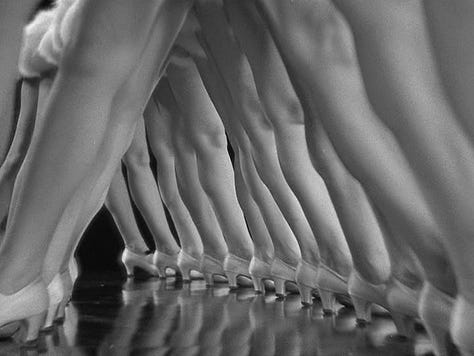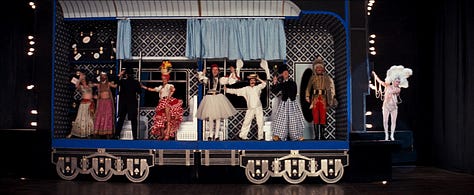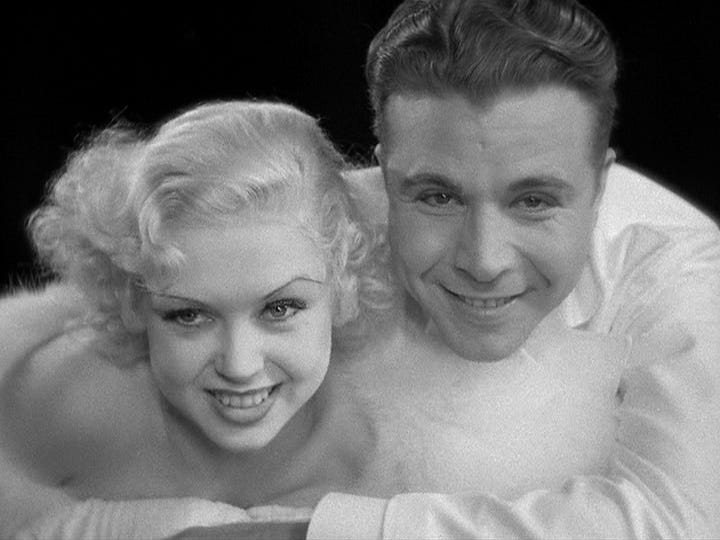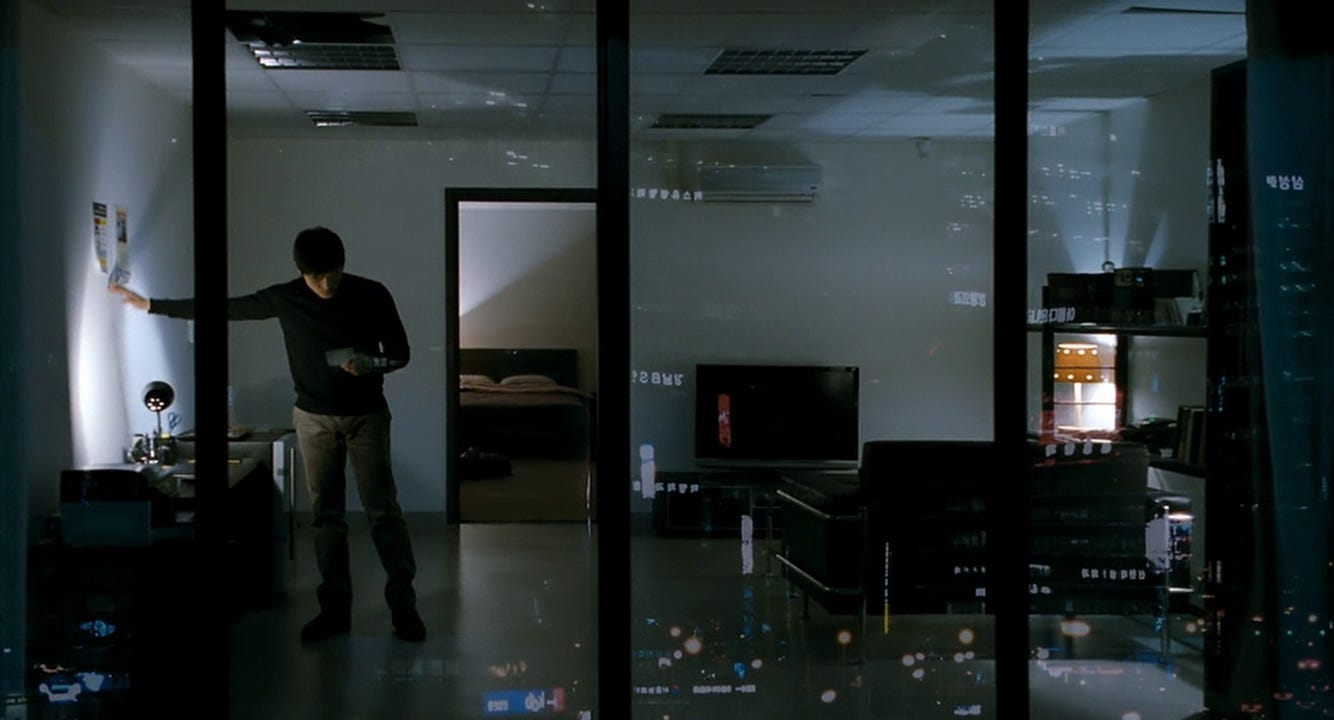Favorite First Watches of January
It was January: the Bar was on the Floor (and the Drinks were Non-Alcoholic)
It’s been (it’s been) about two weeks since I’ve seen anything like sunshine instead of a crushing miasma of dispassionate gray in a perpetually overcast January, and — although those are the perfect conditions for watching movies, all it makes me want to do is watch bad movies. I’ve been on a treadmill of braindead cinema this month, and my Letterboxd diary looks like a graveyard of failed action franchises, flop remakes, and whatever’s going on in the latest Statham movie (which I loved). I did watch some good movies, though, and they’re catalogued here!
The monthly streaming newsletter will be back in the first week of March with a host of fun new programs, so keep an eye out! Here’s how I started off my New Year (with plenty of sex and violence, it seems). Until March, all I do is dream of you, the whole night through…
Frankenhooker (1990)
Director: Frank Henenlotter

Ladies: if you’re killed in a horrific freak accident, do you trust your partner to lovingly reconstruct and reanimate you without making “improvements” to your body? Of course you don’t: men are dogs (with respect to my male-identifying readers), and their sense of entitlement to (and judgment over) women’s bodies extends beyond the grave. (It’s infuriating, for example, that Hugh Hefner, arbiter of late 20th century masculinity, is buried next to Marilyn Monroe, a woman he had no relationship with beyond building an empire off of her body — after printing nude photos of her without her consent in the inaugural issue of Playboy magazine). Independent filmmaker Frank Henenlotter built a cult following over the years by using the comparatively permissive space of late 20th century NYC to stage outrageous body horror comedies — including classics like Basket Case (1982) and Brain Damage (1988) — as pointed social commentary. For Frankenhooker, he journeys into the heart of darkness (New Jersey) to plumb the true depths of human depravity (the Bridge and Tunnel Crowd). A suburban man (James Lorinz, who looks like an even more pathetic Andrew McCarthy) is devastated after the tragic loss of his curvy fiancée (Patty Mullen), whom he mourns by retreating into his lab, where he regularly drills into his own head. A bioelectrical specialist, he decides to reconstruct and reanimate his dead bride à la The Bride of Frankenstein (1935): but if he’s going to bring her back, he’s going to bring her back in the ideal form (sans fat). To construct the perfect woman, he travels to Times Square and siphons off a group of street-walking sex workers, whose disembodied parts he uses to build his beloved a new body piecemeal. Sometime around the point that he’s testing disembodied, individual breasts for perfect buoyancy, I realized that I loved this movie. Patty Mullen, once reanimated, is absolutely fantastic as the titular Frankenhooker, using body language and an almost vaudevillian sense of comedy to sell the conceit of a women emboldened by dozens of sex workers living inside of her and let loose on the isle of Manhattan: “Want a date? Looking for some action? Need some company? Got any money??” Subversively feminist, darkly hilarious, and operating on a level of outrageousness that smooths over the crass conceit and non-politically correct elements of the era, you just kinda have to love that movies like Frankenhooker exist. It’s Poor Things (2023) by way of Merrie Melodies (meaning the humor actually lands).
Frankenhooker (1990) is streaming on Peacock, as well as Amazon Prime and Tubi (both free with ad breaks).
The Boy Friend (1971)
Director: Ken Russell
“Sawyer, you listen to me,” producer Julian Marsh (Warner Baxter) tells ingénue Peggy (Ruby Keeler) in 42nd Street (1933), right before she takes the stage for opening night of his new Broadway show. “You've got to go on, and you've got to give and give and give. They've got to like you. Got to. Do you understand? You can't fall down. You can't because your future's in it, my future and everything all of us have is staked on you. All right, now I'm through, but you keep your feet on the ground and your head on those shoulders of yours and go out, and Sawyer, you're going out a youngster but you've got to come back a star!” In the onscreen mythology of the early 20th century stage movie musical, there’s only one possible solution when the chips are down and backs are against the wall (or the hounds are coming for your psychosexual possession movie): put on a big show! Ten days after finishing his sacrilegious masterpiece, The Devils (1971), which would go on to become one of the most controversial films of all time (it is still being held captive by Warner Bros., who refuses to release Russell’s full film to home video or properly restore it for streaming), British filmmaker Ken Russell decided to do just that, beginning work on this post-modern musical pastiche of early 20th century stage culture, captured in early sound-era musicals like The Broadway Melody (1929) and The Hollywood Revue (1929). Adapted from a 1953 stage show — which starred a young Julie Andrews — the movie reconfigures motifs, songs, and gimmicks from movie musicals over the years, including the Busby Berkeley spectacles of the early 1930s and the groundbreaking work of the “Freed unit” at MGM. For his ingénue, Ken Russell cast his friend (and recently retired model) Twiggy, who is absolutely delightful as a gangly cockney stage assistant thrust into the show after the leading lady (Glenda Jackson) is injured. The film follows the execution of the show, performed for a Hollywood movie producer who just happens to be in the audience that night — and his imagined translation of the show into elaborate Hollywood musical set pieces…including a flip of early Fred Astaire/Ginger Rogers musical Flying Down to Rio (1933), in which chorus girls memorably ride atop open-air airplanes. The Boy Friend may have been Russell’s silly escape after the taxing strain of The Devils, but it wound up being an entire beast of its own (as musicals tend to do), incorporating a staggering number of musical set pieces memorably costumed in 20s period attire by Russell’s then-wife (and go-to costumer) Shirley Russell, who I personally think is one of the most underrated creative forces in UK cinema. Ken Russell was a master of capturing opulence, scale, and artifice for the screen (he’s personally one of my favorite filmmakers), and The Boy Friend is no exception. It’s streaming on Criterion Channel as part of their showcase of the director’s work, but to really get a sense of the director’s utter mastery of pastiche, I’d look outside the program at films like Tommy (1975), Lisztomania (1975), and Valentino (1977). Never forget that you can always just put on a big show to solve all your problems.








The Boyfriend (1971) is streaming on The Criterion Channel.
The Destroying Angel (1976)
Director: Peter de Rome

Amanita virosa, commonly known as the Destroying Angel, is a deadly poisonous mushroom found mostly in mixed oak-hardwood conifer forests of the United Kingdom. The deceptive fungus takes its time with its victims: initial symptoms include severe vomiting and diarrhea, after which the worst seems to have passed; within 3 days, however, ingestion leads to death as the toxin works its way through the liver and kidney, causing both to shut down. I’ve never foraged for mushrooms, deadly or otherwise, but a few years back, Mo and I attended a screening of Good Hot Stuff (1975), a documentary-ish film cataloging the work of groundbreaking gay NYC porn studio, Hand in Hand Films, programmed by Elizabeth Purcell of Ask Any Buddy, a vital podcast documenting queer erotic film history. You never really know about yourself until you’re body-to-body in a studio space in Greenpoint watching a fisting scene set to ambient elephant sounds with a room full of gay men. Wherever there's magic and make-believe and an audience, there's theatre! At that screening, we were introduced to the work of Peter de Rome, a pioneering erotic filmmaker who made several films for Hand in Hand — including Underground (1972), a gay pornographic short filmed on an actual NYC subway train while in service; Adam & Yves (1974), which contains a beautiful pas de deux between two men and the last known footage of Greta Garbo (captured clandestinely by de Rome on 8mm); as well as this fascinating feature, programmed as part of Adam Baran’s “Narrow Rooms” series at Anthology Film Archives, which showcases cult and hard-to-find queer films (a must for anyone interested in queer cinema and always a total blast). Of course Mo — my intrepid erotic gay art specialist — and I also made the trip to Anthology to watch The Destroying Angel (1976), a surreal blend of countercultural soul-searching, hardcore gay sex, and striking horror visuals. Based on Edgar Allan Poe’s short story “William Wilson,” which tells the story of an amoral man haunted by a righteous doppelganger, the film tells the story of a prospective seminarian who — while on sabbatical — falls into a decadent spiral of lust, fueled by psychedelic mushrooms. As he begins seeing visions of a doppelganger engaged in sexual acts with other men, the film turns surreal, blending elements of horror, drug cinema, and pornography. As an amanita virosa, picked at the behest of his villainous shadow, works its way through the protagonist’s system, he’s torn between religious guilt, desire, and a futile search for peace. A fascinating curio of early queer horror, The Destroying Angel is a terrific example of the creativity and ingenuity of The Golden Era of Porn and the distinct contributions of groundbreaking gay filmmakers. It is, uh, pornography, so just keep that in mind if you choose to watch!
The Destroying Angel (1976) is streaming online! Many places!
The Shout (1978)
Director: Jerzy Skolimowski
“You know you make me wanna SHOUT!” The Isley Brothers famously sang in 1959, and again, for decades to come, at every wedding in recent American history. But that’s the opposite of what you’ll want to do after watching this bizarre, indescribably upsetting art horror flick from underrated European Auteur Jerzy Skolimowski, a Polish filmmaker who — despite recent attention for his latest release, EO (2022) — still remains something of an underrated auteur in the international cinema canon. Set (and shot) at the stormy seaside of Devon in England, the film is an adaptation of a short story by Robert Graves, which depicts the tumultuous decline of a couple at the hands of a mysterious guest. The film employs a framing mechanism of a lively cricket match at the estate of a psychiatric hospital, as the aforementioned mysterious man (Alan Bates) recounts to an estate visitor (Tim Curry) how a local experimental musician (and church organist), played by John Hurt, fumbled a bad bitch (Susannah York). He recounts how he first came to visit the couple, as well as the power he professes to possess after time spent in Aboriginal spaces in Australia, which changed all of their lives forever: a primal shout, which can kill anyone in its radius. If that sounds like a flimsy set-up for a movie, it kind of is, but the denouement is so compelling and seductively ambiguous that it makes for an absolutely thrilling watch. Yes: there is a big shout, and the sound of it is so memorable that I have to think it had an impact on several horror filmmakers, including David Lynch (I can’t find anything about him specifically discussing The Shout, though I know he’s a particular fan of Jerzy’s 1970 classic Deep End). The film’s eerie, experimental soundtrack came at the hands of Michael Rutherford and Tony Banks, two of the founding members of prog rock band Genesis, adding to the film’s striking sound design. Skolimowski’s acclaimed film competed for the Palme d’Or at Cannes, where it tied for the Grand Prix alongside a Marco Ferreri film called Bye Bye Monkey.
The Shout (1978) is streaming on The Criterion Channel, as well as Amazon Prime and Tubi (both free with ad breaks).
I Saw the Devil / Angmareul boatda (2010)
Director: Kim Jee-woon

I don’t think Vince will ever forgive me for innocently suggesting this Korean thriller, which — who knew! — contains an almost soul-crushing amount of onscreen violence, for movie night. Nothing cheered him up, even when I kept singing this film’s title to the tune of “I Shot the Sheriff” to try and lighten the mood. Yes, it certainly crushed Vince’s spirit, but only re-invigorated mine. I can’t remember a time in recent memory that a movie has affected me so deeply, disturbing me down to my very core. I regularly gorge myself on slashers, thrillers, and other media about the macabre and the morose (for reasons that have not yet been unpacked in therapy), so for something to really unsettle me, it’s got to be something that’s extremely successful in its execution. “Revenge is for the movies,” a woman tells the protagonist of I Saw The Devil (2010), a movie about one man’s fraught quest for revenge: even though he’s in one, it’s a real-life lesson he’s going to learn the hard way. Nothing can truly fill the emptiness violently carved out at the loss of someone…particularly if that loss was rendered prematurely, in an act of unspeakable grotesquery. Korean superstar (and newfound obsession) Lee Byung-hun — who has collaborated with director Kim Jee-Woon on a number of acclaimed films over the years — stars as a National Intelligence Service agent whose pregnant fiancée dies at the hands of a cold-blooded serial killer, played with terrifying commitment by Choi Min-sik (of Oldboy infamy). Taking just two weeks off of work, the NIS agent devotes himself to tracking, catching, and torturing the truly dastardly killer, vowing to make him suffer as she did. This warpath turns tricky when he handily catches his prey…and the real game of cat-and-mouse begins: how do you even begin to quantify something like that? How much suffering can recoup the cost of a human life? How deep into hell are you willing to go to fight the devil? Director Kim Jee-woon, one of the definitive filmmakers of South Korean cinema, is no stranger to on screen violence: after debuting with dark comedy murder hotel classic The Quiet Family (1998), which also starred Choi Min-sik, Kim made a number of violent aughts classics, including international crossover horror hit A Tale of Two Sisters (2003) and the acclaimed neo-noir mob movie A Bittersweet Life (2005), which also starred Lee Byung-hun. In I Saw the Devil, that violence feels oppressive and transformative, almost suffocating the viewer with despair. A masterclass of style anchored by two painfully exposed performances, the film garnered a number of nominations at the Grand Bell Awards, which are sort of the South Korean Academy Awards, including Best Film and Best Actor nominations for both its two stars. Staggeringly bleak, this film makes Bong Joon-ho’s Memories of Murder (2003) look like Okja (2017) in comparison. Trigger warning here for sexual assault, gore, cannibalism (how was I supposed to know??), and scenes of violence that some (such as my fiancé) might find difficult to watch. It’s not for the squeamish, but if you can tough it out, you might really enjoy it. Or you may never forgive me!
I Saw the Devil (2010) is streaming on Hulu.







